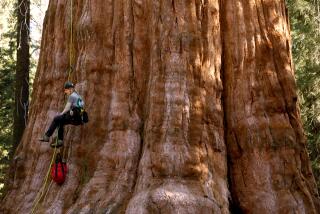Rooting for the Big Tree
- Share via
Folks around here simply call it the Big Tree.
The towering bur oak surrounded by fields of soybeans needs no other name.
It’s safe to say it’s the only thing in the tiny village of McBaine (population 17) with 6,000 Facebook fans.
People look at the Big Tree with respect. They come to north-central Missouri from miles away, even from other states, to sit in its shade and run their fingers over the ridged bark. There’s the feeling there must be something special about a tree that sprouted back when English settlers were still establishing their colonies on the East Coast.
It has survived 9-foot-high floods, a tornado that demolished neighboring barns, lightning strikes, fire. Believed to have taken root around 1660, the Big Tree stands 90 feet tall, with a symmetrical canopy stretching 130 feet across. But even this tree — considered Missouri’s largest and oldest bur oak — cannot survive forever.
“It’s in decline,” says Chris Starbuck, a plant science professor at the University of Missouri. “It’s dropping a lot of branches.”
Last year, he and other local arborists gave the tree a spring cleaning in an attempt to slow its decline. They clipped off dead limbs and aerated the soil that had been packed down by the parked cars of countless visitors.
John Sam Williamson, the farmer whose family has owned the Big Tree since 1835, says he’s heard from people who want him to fence off the tree to prevent damage from visitors. He’s against the idea.
“People call it our tree, but we don’t look at it like that,” Williamson said. “It’s part of the community.”
The two-lane road running beside the tree has taken the name of “Burr Oak Road,” albeit spelled incorrectly with two Rs. A local politician launched his campaign under the tree a few years ago. Hearts carved in the tree’s bark and scattered bits of beer bottles testify to the countless late-night trysts and college student parties that have taken place at the Big Tree.
People come in more solemn moments, too.
On a recent Thursday, Brien Muench, 20, slipped a diamond ring on 21-year-old Julie Schunk’s finger under the tree. Muench said the old oak was one of the first places he took Schunk when they met, so it was natural for him to return to propose marriage. She said yes.
Minutes after they left, a Dominican friar, Father Simon Felix Michalski, came to pray.
“It’s very, very peaceful,” he said. “I saw a praying mantis and a hawk, which are good signs.”
Some years back, Williamson says, a dying man asked to be buried under the oak. Williamson refused, not wanting the tree to become a gravesite. The man decided to be cremated, and his ashes were scattered around the tree instead.
It’s easy to see why some would consider the oak the ideal final resting ground. There’s an otherworldliness to a 350-year-old tree living in solitude among soybeans.
But the Big Tree is dying. Not anytime soon, perhaps, because a tree like that takes a long time to die. But Starbuck says the continuing presence of dead limbs means the tree’s engine is slowing.
That’s why Starbuck and others have grafted about two dozen twigs from the tree, creating clones that will carry on the its remarkable genes.
Starbuck has three grafts at his house in neighboring Huntsville. They’ve unfurled fuzzy green flowers from the tips of slender 2-foot-high trunks.
Other little Big Trees live in a University of Missouri greenhouse. A few reside with an arborist in Jacksonville, Ill.
Williamson’s graft is older. It’s already grown into a sturdy 20-foot tree in his front yard.
Dou writes for The Times.





